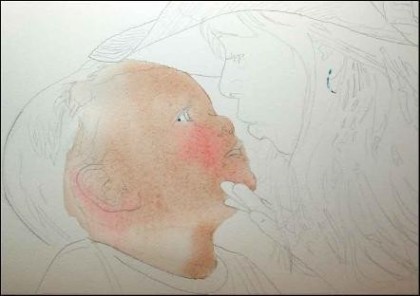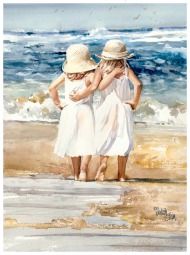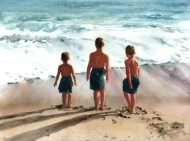Painting Portraits Step by Step
Begin your painting as usual by sketching the outlines of the portraits lightly in pencil.
Determine where you want the white of the paper and use Maskoid to protect those areas while you paint. (Note the blue maskoid below.)
Skin colors are achieved by a mixture of Yellow, Red and Blue. Many red, yellow & blues will work - you can experiment. A combination of Yellow Ochre, Alizarin
Crimson and French Ultramarine Blue is also very effective. It is best to avoid the stains & granulations, however - they won't lift off for highlights and they make grainy skin tones.
Start with yellow in your mixing tray and add alot of water. Tint with red (I like Scarlet Lake & use it alot for pink cheeks.) To get a truer skin tone, add a tiny bit of blue to give it a
natural skin tone.
Wet one area at a time with a wet wash. The paper should not be pooled with water - but more like velvet. Drop color into the areas of the face.
Continue painting the skin tone throughout the painting.
Highlights can be lifted out with a sponge when the wash is still wet. Another method is by using a dry brush. Lift the paint off of the wet surface, wipe the brush dry and continue the process until the hightlight is achieved.
Once you have painted the light values throughout your painting, begin the medium values.
For shadow areas, mix more blue into your paint and drop into the darker area. Use a wet sponge to wipe off highlights.
Avoid balloons from appearing in your painting. They are caused by wet paint or water moving into an area that is dryer. If you need to add more shadow and you're concerned that you may create a
balloon - allow the painting to dry completely first. You can gently spray water over the area again and drop in more color and shadow.
Continue with the shadow areas of the skin in both faces. Detail & the darkest darks will be added as part of the final steps of the painting. This process insures that your painting remains transparent.
Children tend to have very pale skin and have no visible lines. Shadow areas need to be very subtle to insure they do not look like "little old people."
Paint the light & medium values throughout the painting. In this painting, yellow is dropped into an area of the baby's face to give the apprearance of sunlight on
the face. Hands and feet often are enhanced by a tint of red or pink.
If your color relationships are working now, you are ready to finish the painting with the darkest darks and detail.
Dark areas should be balanced throughout your painting.
The darkest darks and most of the detail should be in the faces. That insures that they remain the focal point of the painting.











